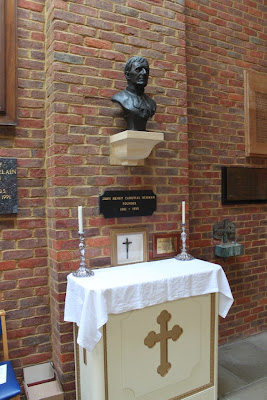 The Chapel
The ChapelBishop Mark Davies of Shrewsbury gave the first Conference. His address was greeted with nearing on rapturous applause from the brethren. A priest of some distinction sitting next to me said that he had never heard the like from an English Bishop! I probably won’t be able to capture the atmosphere but Bishop Mark spoke from the heart about his own priesthood and wasn’t afraid to challenge us in ours. His words spoke of a love for the Priesthood and for the Church but in a way that addressed the real situation most priests there recognised as their own - sadly, not a frequent occurrence for many of us. And he made us laugh as well - a rare talent indeed!
He thinks that the crisis in vocation is partly due to many priests (and people?) failing to recognise the gift that the Priesthood really is and following the Holy Father, pointed to St John Mary Vianney as the reference point and unsurpassed example for our priesthood. Bishop Mark has sent his new seminarians to train for a year at the seminary in Árs set up by Venerable Pope John Paul II - in an attempt to give them the opportunity to pick up something of the Curé’s spirit.
Bishop Mark asked what it is that the Priest brings to the world and answered that it is love for God that he brings, to the most abandoned places of the world. I noted that he said love for God, not just human love, our own love, or practical help, or love for each other but love for God.
Quoting St Paul writing to the Ephesians he asked us if the love with which we were first called and brought us to the Priesthood had been abandoned in many priestly hearts, asking us to recapture that first enthusiasm.
Recognising that we can often struggle, he recalled the story of St John Vianney whose parishioners were getting up a petition to his bishop to say that he wasn’t fit to be their priest - the Curé asked to sign it himself!
In a refreshing insight that hopefully reflects the direction of travel in his own diocese, Bishop Mark pointed out that when John Vianney first went to Árs the church building itself was in a state of very poor repair with most of the people lapsed and a virtually non-existent congregation would have been very high on any diocesan list of places to close!
Bishop Mark didn’t exclude himself and his fellow bishops from challenge either - recounting the story of the founder of the Neo-Catechumenate who would often approach bishops with the question, “My Lord, do you believe in God?”
He also told us of a recent conference for bishops on the New Evangelisation where some of the bishops were rather put out to discover that the first session was not about evangelising others but evangelising - starting with an invitation to go to Confession immediately after the talk! (He didn’t say how many availed themselves of the opportunity.)
Another of the talks was given by Mgr Andrew Wadsworth, who has been intimately involved with the new translationof the Roman Missal. He gave us some excellent insights into the new translation and the aim to be faithful to the Latin original under the prescriptions of Liturgiam Authenticam, which included the faithful translation of the rubrics - particularly those that indicate the norm of offering the Mass ad orientem, which are sprinkled throughout the canon (in both the Latin and English Missal) which some had asked to be removed. As the Monsignor explained, he could only translate - not add or subtract to the text!
There are other accounts of the event by other blogging priests who were there and you can see plenty of photographs at Fr Sam's Flickr page.
There are other accounts of the event by other blogging priests who were there and you can see plenty of photographs at Fr Sam's Flickr page.





I think it was St John writing to the church in Ephesus - not St Paul - in Revelation 2:4
ReplyDeleteIt sounds like Bishop Davies was just the ticket for the priests assembled. I’m glad he referenced St. John Vianney and in such human terms.
ReplyDeleteWe all know – or think we know – St. John Vianney. He is of recent memory and it is not so long ago that people still lived who had seen him in the flesh. With the passage of time we tend to romanticize the past and past people. Our memory is selective and thus we always speak of the “good old days” - as if the passage of time confers canonization. But the passage of time only confers age and, despite protestations to the contrary, age doesn’t necessarily confer wisdom. More often it confers memory loss.
The remarkable thing about St. John Vianney is that externally he was unremarkable. He was not a giant physically - no more than was St. Ignatius - being about five feet two in his stocking feet, as was the saint of Loyola. Thus he was frequently dismissed, especially by the diocesan ‘giants’ of his day. One has the impression of a Nathaniel-esque “Did anything good ever come out of Ars..?” take by the chancery bureaucrats.
It is well that the Curè is the Patron of Parish Priests. He knows the territory. He has “been there, done that” in spades. It is sometimes noted that the Gospels never described Our Lord physically. People marveled at what He said and what He did – not how He looked. It was the same with John Vianney. He wasn’t projecting himself but Our Lord. And Christ showed through him to the people who had the faith to recognize it.
Not a bad example to follow!